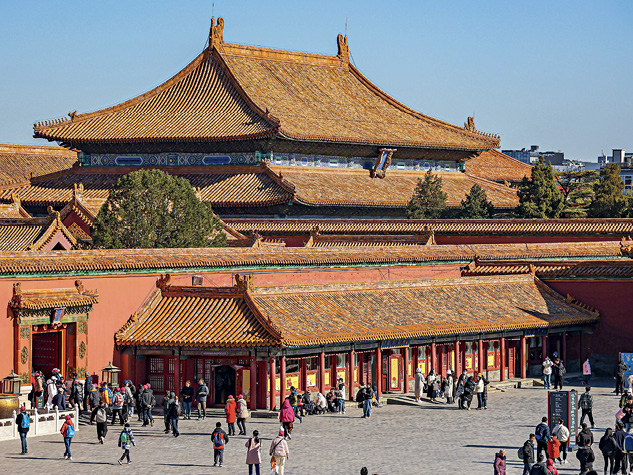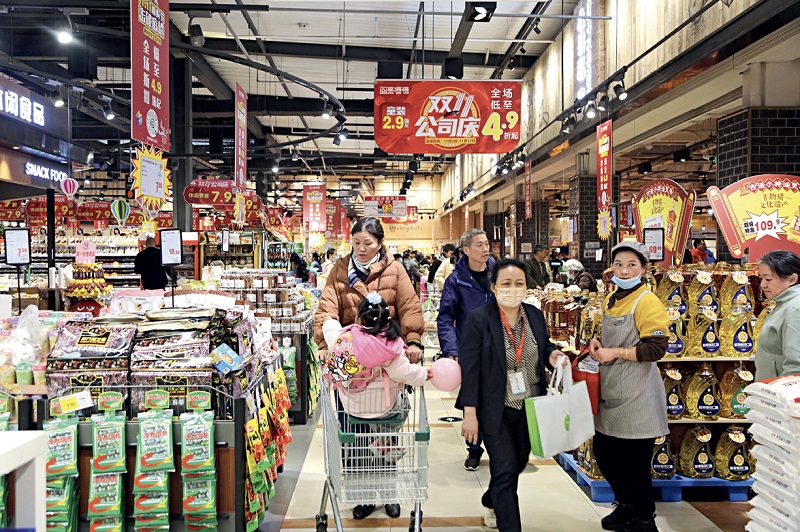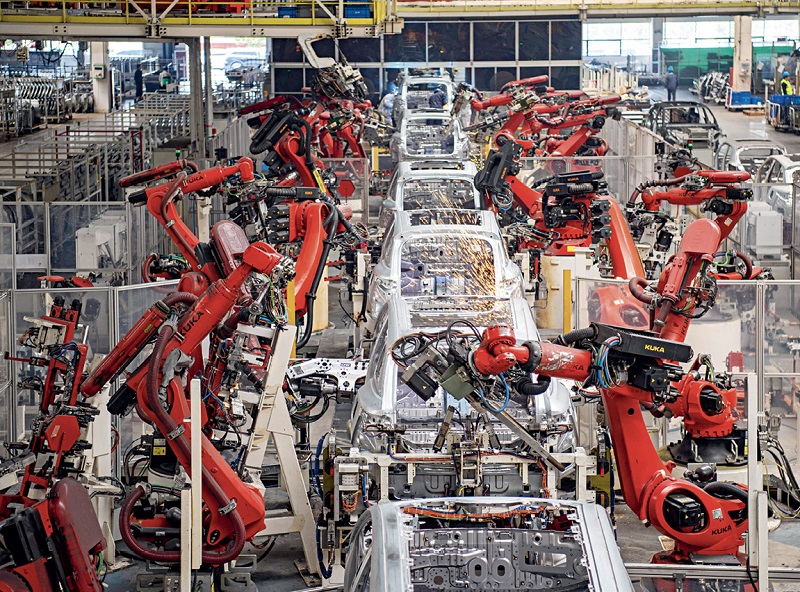As the world’s second largest economy, China’s economic upturn is having a positive effect on the global economy. The Trade and Development Report 2023, released by the United Nations Conference on Trade and Development in early October, said China’s economy had picked up this year and will grow more than 10 times faster than that of the eurozone, serving as a major contributor to global economic growth.
The Chinese economy grew by 5.2 percent year-on-year between January and September this year, according to data released by the National Bureau of Statistics (NBS) on October 18.
“With its current growth momentum, China will be able to fulfill its target of five percent GDP growth for this year,” Sheng Laiyun, deputy head of the NBS, told a press conference on the day of the data’s release.
“During the first three quarters, supply and demand also saw recovery, and the real economy sector showed positive signs,” said Sheng. According to the NBS, the major indicators of the Chinese economy, including investment, consumption, and employment, have all gathered steam over recent months.
“The Chinese economy picked up from a low base in the same period last year with better-than-expected performance in the first three quarters. The momentum of sound and stable economic growth has become even more of a normal,” said Wen Bin, chief economist at China Minsheng Bank.

The Forbidden City in Beijing on November 11, 2023.
Mainstay Growth
Consumption, a key economic driver, contributed 83.2 percent to China’s GDP growth in the first three quarters of this year. Retail sales of all consumer goods went up 6.8 percent year-on-year in the period to around RMB 34.21 trillion (US $4.77 trillion). Online retail sales jumped 11.6 percent year-on-year.
China’s consumption has rebounded since the beginning of this year as the economy has recovered and in response to pro-consumption policies. Consumer spending on services saw rapid increase and underpinned economic growth strongly, Sheng said.
According to the NBS, retail sales of services surged 18.9 percent year-on-year during the first three quarters. Per-capita spending on services went up 14.2 percent year-on-year during the nine-month period.
Travel has been rebounding rapidly since earlier this year. The travel boom during the holidays in the first three quarters suggested an almost revengeful consumption by Chinese consumers. Brick-and-mortar businesses, from restaurants to cinemas, have also made a strong comeback.
China has not seen any downgrading of demand during the first three quarters. From the first quarter (Q1) to the third quarter (Q3), retail sales of gold, silver and jewelry, as well as those of sports and recreational goods, went up 12.2 percent and 8.3 percent year-on-year, respectively. Sales of new-energy vehicles rose 27.7 percent on a yearly basis.
An uptick in employment has shored up the consumption sector. In Q1-3, the surveyed urban unemployment rate in China stood at 5.3 percent, down 0.3 of a percentage points from the same period in 2022. Per-capita disposable income reached RMB 29,398 (US $4,018) during the first three quarters, up 6.3 percent year-on-year.
Investment in infrastructure went up 6.2 percent year-on-year in the first three quarters. To improve the urban living environment, urban village renewal in megacities has been carried out in many regions across the country. These infrastructure projects are expected to give a strong boost to investment. According to the Ministry of Housing and Urban-Rural Development, the number of new urban village renewal projects, which aim to renovate old communities in urban areas across China, reached 49,800 between January and August this year. It plans to launch 53,000 such projects covering 8.65 million households nationwide this year.
With supporting government policies, the property sector has also started to rebound. On August 31 this year, the financial authorities encouraged the easing of restrictions for first-home buyers, and allowed them to enjoy lower down payments and interest rates on mortgages. Major cities, including Guangzhou and Shenzhen in Guangdong Province, Beijing and Shanghai, implemented the policy in September.
The number of transactions involving residential homes in China’s 70 major cities grew 2.8 percent month-on-month in September, the first positive growth following five straight months of decline, the NBS said.

Consumers shopping at a supermarket in Lianyungang, east China’s Jiangsu Province on November 11, 2023, China’s annual “Double 11” shopping festival.
Bouncing Back
Industrial production during the first three quarters showed sound recovery. The value-added industrial output, an important economic indicator, saw four percent year-on-year increase in Q1-3. The output of hi-tech products, such as solar cells and new-energy vehicles, increased as both domestic and external demand increased.
Another sign of the rebounding economy is the increased electricity consumption. Power usage during the first three quarters totaled around 6.86 trillion kilowatt-hours, up 5.6 percent from a year ago.
To support enterprises, especially micro and small firms, the central government has continuously introduced preferential policies. Taxpayers with monthly sales revenue of no more than RMB 100,000 (US $13,668) will continue to be exempt from value-added tax until the end of 2027, Chinese financial authorities said in August this year.
The China Association of Small and Medium Enterprises announced in October that the outlook for small enterprises improved in Q3 from Q2. Performances of industrial, transportation and logistics companies enhanced greatly.
The performances of micro and small enterprises are better than those in the same period of 2022, and are also beyond the 2021 Q1-3 level. Some companies still face difficulties including rising costs, declining turnover, and fund shortages, and have to cope with fierce competition. More support for the firms is needed to further boost domestic demand and enhance confidence, the association said.
"There is still room to improve support for the real economy through monetary and fiscal policies in the fourth quarter, especially by directing funds to support micro and small enterprises and boost consumption," Xu Hongcai, deputy director of the Economic Policy Commission at the China Association of Policy Science, told the media.

Industrial robots are welding vehicles at a production line for smart new energy vehicles in Jinhua, east China’s Zhejiang Province, on April 26, 2023.
Better than Expected
Data from the General Administration of Customs of China (GACC) showed that China’s foreign trade fell 0.2 percent year-on-year in the first three quarters. Exports grew by 0.6 percent year-on-year, while imports dropped 1.2 percent from a year ago.
The year-on-year growth of global foreign trade is likely to stay below two percent this year. China’s foreign trade went up amid headwinds between August and September, largely a result of growing trade with emerging economies, Xu said.
China’s trade with countries participating in the Belt and Road Initiative, proposed by China in 2013 to boost connectivity along and beyond the ancient Silk Road routes, rose 3.1 percent year-on-year to RMB 14.32 trillion (US $1.96 trillion) between January and September this year, accounting for 46.5 percent of its total foreign trade value in the period, the GACC said.
Hi-tech products are gaining an increasing share in China’s exports. The exports of lithium-ion batteries, manned electric vehicles and solar cells, which are the new three major products of China’s exports, increased by 41.7 percent year-on-year.
SK On Jiangsu Co. Ltd., a company based in Yancheng, Jiangsu Province, is a manufacturer of electric vehicle batteries. As of August this year, it had exported lithium-ion battery products worth more than US $1.7 billion, exceeding its total exports last year. The company is a joint venture between SK Group, the third largest multinational in the Republic of Korea (ROK), and EVE Energy Co. Ltd., a Chinese lithium-ion battery company based in Guangdong Province.
According to the company, it enjoyed around RMB 1.1 billion (US $150 million) in tariff reductions in January-September this year through preferential policies from the Regional Comprehensive Economic Partnership, a free trade agreement consisting of 10 Association of Southeast Asian Nations (ASEAN) countries, as well as China, Japan, the ROK, Australia and New Zealand. Certificates granted by local customs in Jiangsu have also helped cut the time needed for its products to pass through customs.
External demand will rebound along with global economic recovery in the fourth quarter. As new industrialization and cutting-edge manufacturing remain a focus of government work, industrial upgrading will drive the real economy more strongly. Semi-conductor, 5G and new material industries will continue their rapid growth, Wen said. 
(The article was first published by Beijing Review)
LI XIAOYANG is a reporter with Beijing Review.
